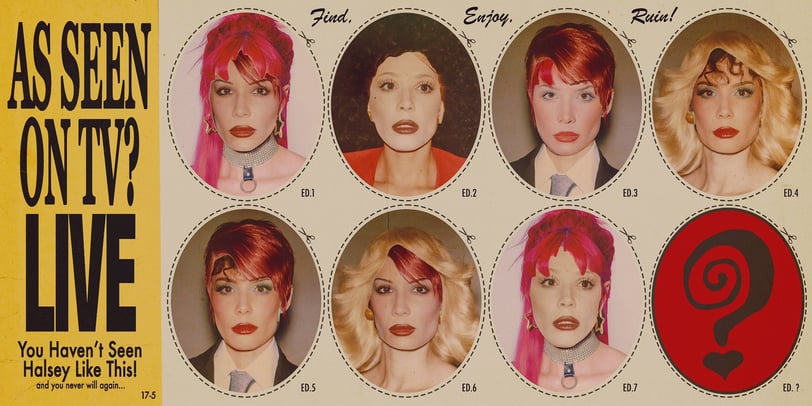Halsey's The Great Impersonator: Album Analysis
11/8/20245 min read


The Great Impersonator is the latest gem in Halsey’s repertoire, an album that not only redefines her style but also delves deeper into the concept of authenticity and self-discovery. As the enigmatic title suggests, Halsey invites us to reflect on the idea of being “the great imitator” in an era of multiple identities and ever-changing projections.
This new project comes at a key moment in Halsey’s career, which has evolved significantly to embrace new influences and themes without losing its essence. The Great Impersonator promises to thrill her long-time fans and attract new listeners, on a musical journey full of honesty, deep emotions and creativity that challenges the limits of her discography to date.
What is the meaning behind the album title?
In The Great Impersonator, Halsey explores themes of identity, transformation, and the different masks we all wear in our daily lives. The title suggests a play between reality and fiction, as if Halsey herself takes on multiple roles as she speaks about her experiences and emotions. This idea of the “great impersonator” evokes the pressure to fit into multiple versions of oneself, both personally and publicly, especially under the constant scrutiny of media and fans.
Through The Great Impersonator, Halsey not only demonstrates her evolution as an artist but also encourages her listeners to question their own “masks” and find the authentic amidst the performances. The album becomes a sort of “mirror game” where each song reveals something different, challenging the listener to discover what lies behind each interpretation.
Tracklist Insights and Artist References
The Great Impersonator is carefully crafted to take listeners on a sonic journey that spans a variety of musical eras and styles. This tracklist is comprised of songs that, taken together, explore Halsey’s personal and artistic transformation. Each track reveals a distinct “role” or “identity,” evoking influences from music icons who shaped her style and essence. Beyond production and sound, the album is filled with references to artists who have deeply influenced her creative evolution.


Singles
Album Visuals: Exploring Covers and Designs
The Great Impersonator's aesthetic reflects Halsey’s versatility and multidimensional approach as an artist. Rather than limiting herself to a single visual identity, the album deploys a series of images and concepts that explore the duality between authenticity and performance. This approach, evident from the cover art to the promotional videos, is designed to immerse the listener in a visual and emotional journey that accompanies the music.
Album Covers: Halsey released five different covers for The Great Impersonator, each representing a different decade and a different facet of her artistic identity. This variety of covers allows fans to choose an edition that resonates with their personal aesthetic, creating a unique connection between listener and album. Each cover evokes an era, but also reads as a tribute to the icons who have influenced Halsey and as an exploration of how identities are constructed and reconfigured over time.




The End: In “The End,” Halsey explores the inevitability of mortality and the legacy left behind when passing away. The song opens with a soft melody, reminiscent of Joni Mitchell’s introspective style. The lyrics reference the pressure of leaving a meaningful mark, a common theme in artists who face fame from a young age. This single is one of the most profound on the album, where Halsey combines poetic lyrics and instrumentation that increases in intensity towards the end, leaving a feeling of melancholy and reflection.
Lucky: “Lucky” is a tribute to pop hits from the early 2000s. With direct references to Britney Spears' iconic song, Halsey uses the structure and style of this single to explore her own relationship with fame and expectations. The melody is catchy, with a nostalgic touch that pays tribute to Spears without losing Halsey’s identity.
Lonely is the Muse: This track mixes an ethereal atmosphere with lyrics that reflect the duality between being a muse and a creator. The song draws inspiration from the style of artists like Amy Lee, combining gothic rock elements with dramatic and emotional production. In “Lonely is the Muse,” Halsey explores the vulnerability that comes with being the inspiration while also carrying the weight of other people’s expectations.
Ego: With a raw and defiant energy, “Ego” is one of the most intense songs on the album. Halsey explores themes of self-image and narcissism, combining influences from the 90s, especially from alternative artists like PJ Harvey. The song alternates between quiet moments and sonic explosions, reflecting the internal struggle between the desire for authenticity and the need for validation. The lyrics are scathing and honest, addressing the difficulty of maintaining a sense of self in an industry that fuels egos.
I Never Loved You: In this single, Halsey delivers a ballad reminiscent of Kate Bush’s melancholic, dreamy aesthetic. With ethereal production and lyrics filled with nostalgia, “I Never Loved You” explores the confusion and emotional ambiguity following a breakup. It’s a song that focuses on resignation and grief, but also on the release of a relationship that no longer makes sense.
The album is available in both CD and vinyl formats, but finding each collectible cover from different decades has become a Herculean task for the most dedicated fans. Each cover is a unique piece capturing an era, and their limited availability has made them highly sought after in the market.
Visual concept and promotional videos: The Great Impersonator's aesthetic goes beyond the covers. Halsey has released a series of promotional videos that feature her playing different “characters” inspired by these styles and eras. Each video is carefully crafted to represent the identity and aesthetic of the decade it accompanies, creating an immersive atmosphere that transports the viewer to another era. Not only does this showcase Halsey’s ability to adapt and embody diverse styles, but it also allows listeners to explore different facets of the album.
Song lyric design and presentation: The lyrics of each song are presented in a graphic design reminiscent of magazines and fanzines from the decades each song represents. The fonts and colors used in the booklets of the physical editions vary between a psychedelic style on the 70s cover, neon for the 80s edition, grunge for the 90s, and a pop and carefree style for the 2000s version. This design approach reinforces the idea that each song on the album is a time capsule in itself, a visual nod that complements the sound of each era.
Final Thoughts
The Great Impersonator is much more than an album; it is a deep exploration of identity and a celebration of the many facets that make up an artist. Halsey invites us to immerse ourselves in a musical and visual journey that spans eras and styles, while challenging the ideas of authenticity and reinvention. Throughout the album, there is a perceived artistic maturity that reveals her ability to reinvent herself without losing her essence, managing to connect with her audience in a unique way.
The thematic diversity, carefully crafted aesthetics, and innovative marketing strategy behind The Great Impersonator show Halsey's commitment to her art and her desire to offer something meaningful and memorable to her fans. Each song, cover, and visual detail is designed to convey a profound message, offering a journey that resonates both emotionally and intellectually. With this album, Halsey not only reaffirms her place in the music industry, but also redefines her legacy, showing that authenticity can be found in the ability to adapt and transform. The Great Impersonator is a reflection of her growth, a multifaceted work that will continue to fascinate and connect with its audience, reminding us that, sometimes, true identity can be found in each of our interpretations.
Lucky's official video, where Halsey samples Britney Spears.
© 2024. All images used in this post are courtesy of Columbia Records. All rights to the images are owned by their respective copyright holders.
